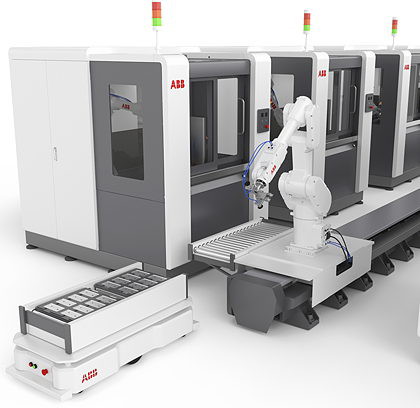- Home » News » Product News
ABB unveils new generation of ready-to-run robot cells

ABB Robotics has launched a new generation of ready-to-deploy application cells at the Automatica exhibition in Germany. The cells, to be marketed under the OmniVance brand, are designed to be easy to program and set up. At Automatica, ABB demonstrated a machining cell that can handle eight different applications, as well as a space-saving welding cell.
The modular cells, consisting of robots, controllers, software and peripheral components, are designed to integrate easily into production lines. They support small batches, thus satisfying the growing demand for low-volume, high-mix production, as well as responding to changing manufacturing needs. They are part of ABB’s strategy to deliver flexible production cells and software that can switch rapidly between different types of product, and can integrate easily with AMRs (autonomous mobile robots).
“We’re facing an unprecedented shortage of skilled labour, alongside global uncertainty and changing consumer demands,” says ABB Robotics president, Marc Segura. “ABB’s robotics and software solutions are responding to those global trends as we deliver more intelligent, more adaptable, more mobile and more user-friendly technology to prepare customers for the future.”
ABB claims that its new OmniVance machining cell is the first standardised machining system that can perform up to eight different applications – including sanding, polishing, cutting, deburring, dry-ice cleaning and surface finishing – in one cell. It can cut set-up times by 92% – from the industry norm of 3-5 days, down to down to 10 hours. Its software is claimed to be the first to offer auto-calibration and path-tuning in one tool, cutting calibration times to just 10 minutes. ABB says the cell can run unsupervised for up to 20,000 hours in harsh conditions, without needing any maintenance.
The cell is based on an IRB 2600 robot, a controller and a turntable, combined with pressure and level sensors and other equipment. Around 90% of the cell is already built, so users only need to focus on tooling and calibration. This level of pre-engineering results in faster set-ups and smaller footprints, making the cells easy to integrate into many different production environments. The use of a standardised design also makes it possible to run up to eight different functions in the cell, often simply by changing the end-effector.
The design is based on real-life stress tests on 2,400 cells. The result is a durable system suitable for harsh conditions and capable of running unsupervised for 20,000 hours before maintenance is needed.
ABB says the cell’s matching machining software is the first to integrate auto-calibration and path-tuning functions in a single intuitive tool. This simplifies the process of setting up new products while ensuring machining accuracy. The software calibrates tools and work objects automatically, cutting re-calibration times from four hours to just ten minutes. Integrated path tuning allows users to edit thousands of path points in half a day, compared to the two days typically needed to obtain high-quality surface finishes.
“Our OmniVance machining cell and software provide new opportunities for unlocking new levels of efficiency, accuracy, and flexibility for businesses across a wide range of sectors – from wood and metals production, through to electronics and automotive,” says Segura. “As product design becomes more complex and labour shortages impact, our machining cell and software can enable businesses to transform their productivity in even the most intricate tasks.”

The new OmniVance FlexArc Compact arc-welding cell occupies 14.3m2, making it the smallest in its class, according to ABB. Up to four fixed robots can be added to boost production capacity without the needing to change the cell structure. A 45-degree gantry mount places the robot at the centre of a three-axis turntable, bringing it close to the workpiece. The cell can be combined with AMRs for flexible automation applications.
The welding cells can be simulated before commissioning using ABB’s RobotStudio simulation and programming tool. The company’s FlexArc software allows users to collect and analyse data to refine performance and improve decision-making and welding efficiency by comparing production data to KPIs (key performance indicators).
If production increases, extra cells can be added. The hardware and software can be replicated, either at one site or across multiple sites, cutting the time and potential risks of adding new cells.
“Welding is one of the fastest-growing applications for automation – and it’s being driven by a lack of labour,” says Segura. “Rising costs and more challenging customer needs make production more complex, meaning manufacturers need simple automation solutions that can adapt easily to changing market needs. OmniVance FlexArc is our answer. We are making it even smaller, more flexible, and easier to use.”
At Automatica, ABB was also demonstrating its OmniVance FlexLoader M modular machine-tending system integrated with a AMR transport. Inside the cell, parts were handled by an IRB 2600 robot guided by an AI-enabled vision system.
ABB Robotics: Twitter LinkedIn Facebook





